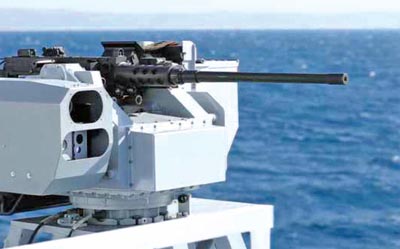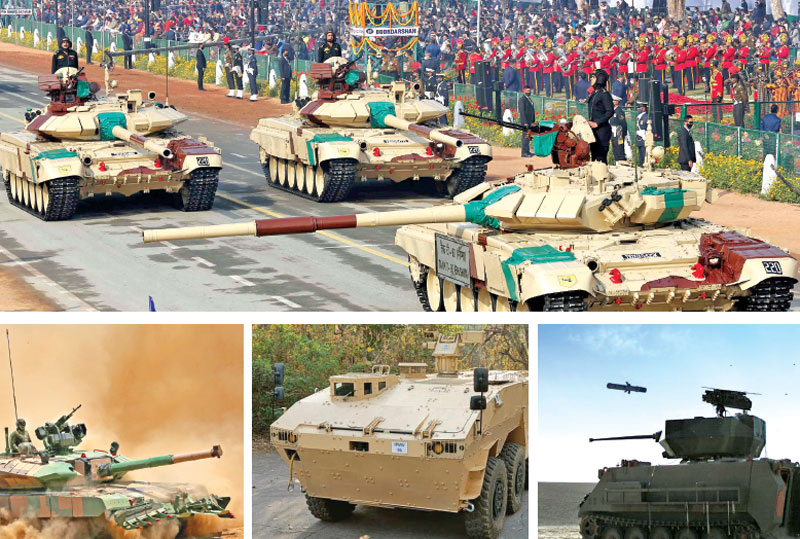Remote controlled weapon stations enable soldiers to fire at targets from safe confines
Atul Chandra
The Indian armed and paramilitary forces have been slow in the adoption of Remote Controlled Weapon Stations (RCWS), which are now commonplace with advanced militaries worldwide. The Indian Army’s large fleet of T-90 and T-72 Main Battle Tanks (MBT) are not fitted with RCWS. They are also not in service with BMP-II Armoured Personnel Carriers (APC). The Arjun Mk-1A MBT was to be delivered with an RCWS fitted with a 12.7 mm heavy machine gun supplied by defence PSU Bharat Electronics Ltd (BEL). However, a newer RCWS appears to have been integrated on the Arjun Mk-1A.

At the recently concluded DefExpo, companies were exhibiting a wide range of vehicles fitted with RCWS and as a result the pace of induction of these systems will accelerate over the next few years. An RCWS enables the soldier to aim and fire at targets from within the safer confines of a vehicle or ship and are fitted with a range of sensors which not only considerably improve accuracy but also engagement of targets at night time or in conditions of reduced visibility. An RCWS also provides an important defence against intruding drones and can also be integrated on Unmanned Ground Vehicles (UGV) providing additional combat capability.
Added Firepower
However, in a positive sign, newly-inducted armoured vehicles are now being delivered to the army with RCWS. The Tata Advanced Systems Limited (TASL) delivered the first batch of Infantry Protected Mobility Vehicles (IPMV) to the Indian Army in April and these were fitted with TASL’s in-house designed and developed RCWS. The army will deploy the new infantry vehicles in high-altitude areas and the new IPMV is India’s first indigenously developed Amphibious Wheeled Infantry Combat Vehicle (ICV).
The ministry of defence (MoD) is also accelerating efforts to induct RCWS. It issued a Request for Proposal (RFP) in November for the procurement of 90 RCWS with the Russian 12.7 mm NSVT (T stands for Tank) heavy machine gun. The procurement is being pursued under the fast-track procedure under the category Buy (Indian) and the urgency of the procurement can be gauged from the fact that the Acceptance of Necessity (AoN) for the procurement was obtained on October 31. The RCWS 12.7 mm NSVT is being acquired for the army’s armoured regiments on the northern borders. As per the RFP, the RCWS must weigh less than 185kg and two axes stabilised system should include single Line Replaceable Unit (LRU) Optronics sensor package featuring a cooled thermal imager, day imager, laser range finder and a video target tracker as a single LRU unit. A system life of 15 years is being sought.
The Indian Navy and Coast Guard are now fitting Naval Remote Controlled Weapon Stations on their ships. The first batch of 25 (15 for the Navy and 10 for the Coast Guard) was delivered in June 2021 by the Ordnance Factory Tiruchirappalli, which is assembling the weapons under licence from Elbit Systems. Elbit Systems bagged the USD 173 million contract to provide Naval RCWS to the Indian Navy and Coast Guard in September 2018. The contract will be performed over a five-year period. Elbit Systems is supplying the lightweight, fully stabilised dual-axis Naval RCWS to be installed onboard a wide range of Indian vessels. The Naval RCWS features a 12.7mm machine gun and ammunition, Elbit Systems’ advanced fire control system and the company’s modular electro-optic suite. The operator remains safely below deck during engagements.

Global Developments
In November, Kongsberg Defence & Aerospace (Kongsberg) and Thales UK inked new a Memorandum of Agreement to work closer together on Protector Remote Weapon Systems (RWS) programmes in a greater number of areas of military capability in the UK and foreign markets. Kongsberg and Thales UK have worked together to promote the Protector RWS in the UK since 2007 and over 1,000 systems have currently been ordered for the UK armed forces. The Kongsberg Protector family of remote weapon stations is the most widely used system in the world, providing commonality among Nato and allied forces.
In November, the United States army awarded Kongsberg a 5-year IDIQ contract valued up to USD 1.5 billion for the continued delivery of the Common Remotely Operated Weapon Station (CROWS). Between the M151 and M153 variants Kongsberg has delivered more than 18,000 systems to the US armed services. The CROWS Tech Refresh is the “next generation” of RWS and provide greater stand-off, increased precision and networking capabilities as well as vastly improved situational awareness in addition to being backwards compatible. In total, Kongsberg has delivered over 20,000 RWS units to more than 20 countries worldwide and is the sole provider of RWS and remote turrets to the US army and US marine corps.
Israeli defence firm Rafael Advanced Defence Systems has more than 40 years of experience with RWS and its Samson 30 mm integrated RWS is its latest offering. The Samson 30 mm integrated RWS’ components include the Trophy Active Protection System (APS) and Spike LR 1&2 missile. The Trophy APS is suitable for any Armoured Fighting Vehicle (AFV) and is fitted on Israeli Merkava 3 and 4 MBTs, Namer heavy APCs and has also been selected by the U.S. military for fitment on the M1 Abrams MBT. The Samson 30mm RWS features an advanced fire control system with a unified user interface that serves the Turret, APS and SPIKE, including battle management and BIT. The Samson 30 mm RWS offers high-survivability with a low silhouette and under armour reloading of its 30 mm automatic cannon. It also features a coaxial 7.62 mm machine gun and a launcher for two Spike Anti-Tank Guided Missiles (ATGM). The Samson 30 mm integrated RWS already has an export customer and is in series production.
At the Eurosatory 2022 defence show held in June, Milrem Robotics displayed its THeMIS Combat Unmanned Ground Vehicle (UGV) equipped with the French Hornet RCWS. Milrem Robotics is Europe’s leading developer of robotics and autonomous systems and its autonomous THeMIS is a highly stable and extremely capable mobility platform, which when fitted with the Hornet new generation remote weapon system, receives a dramatic upgrade to its combat capability making it a valuable asset for different military operations. The Hornet RCWS was developed for the new French “Scorpion” 4×4 and 6×6 armoured vehicle programme and is a highly accurate weapon system. It also offers unique features for UGV applications, which include a specific cleaning system for its optronics as well as the option to flip down the sensors to protect it from dirt and damage. The Hornet RCWS features a protected ammunition feed. These are crucial aspects for an unmanned vehicle operated from a distance.
The Royal Netherlands Army commenced trials with THeMIS UGVs in October, becoming the first western military to start trials with armed UGVs. Adding the THeMIS Combat to even small military units dramatically increase their firepower and capabilities tremendously. THeMIS Combat UGVs will be able to provide direct fire support for manoeuvre forces and act as a force multiplier increasing stand-off distance, force protection and situational awareness. For the Indian Army, a quick transition to armed UGVs in key operational areas could be one way to make up for its overall lack of RCWS, relative to its MBT and armoured vehicle fleets.

